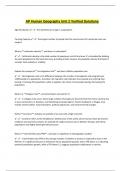AP Human Geography Unit 2 Verified Solutions
Age Distribution ✔️✔️the distributions of age in a population
Carrying Capacity ✔️✔️the largest number of people that the environment of a particular area can
support
What is **arithmetic density**, and how is it calculated?
✔️✔️ Arithmetic density is the total number of people per unit of land area. It’s calculated by dividing
the total population by the total land area, providing a basic measure of population density that doesn’t
consider land usability or arability.
Explain the concept of **net migration rate** and how it affects population size.
✔️✔️ Net migration rate is the difference between the number of immigrants and emigrants per
1,000 people in a population. A positive net migration rate indicates more people are entering than
leaving, increasing the population, while a negative rate shows more people leaving, decreasing the
population.
What is a **refugee crisis**, and what factors can lead to it?
✔️✔️ A refugee crisis occurs when large numbers of people are forced to flee their home country due
to war, persecution, or disasters, overwhelming receiving regions. Factors leading to a refugee crisis
include armed conflict, natural disasters, political oppression, and environmental changes.
Define **ecumene** and give an example of an area with a high ecumene.
✔️✔️ Ecumene refers to the inhabited or settled areas of the world, where humans have permanent
residence and economic activity. An example of a high ecumene area is Western Europe, with dense
populations and highly developed infrastructure.
What is **total fertility rate (TFR)**, and why is it significant in demographic studies?
✔️✔️ Total fertility rate (TFR) is the average number of children a woman is expected to have in her
lifetime. It is significant because it influences future population growth, with a TFR above 2.1 indicating
potential population growth, while a TFR below 2.1 suggests population stabilization or decline.
, Describe the relationship between **urbanization** and **economic development**.
✔️✔️ Urbanization is often linked to economic development, as cities provide access to jobs, services,
and infrastructure, supporting industry and innovation. As economies develop, people tend to migrate
from rural to urban areas, driving economic growth, although it can also lead to overcrowding and
inequality in urban centers.
What does the term **crude birth rate (CBR)** refer to, and how is it calculated?
✔️✔️ Crude birth rate (CBR) refers to the number of live births per 1,000 people in a population in a
given year. It’s calculated by dividing the number of live births by the total population, then multiplying
by 1,000, providing a basic measure of population growth.
What are **guest workers**, and why are they significant in certain economies?
✔️✔️ Guest workers are individuals who migrate temporarily to another country for work, often in
sectors with labor shortages, such as agriculture, construction, and hospitality. They are significant
because they help meet labor demands, often contributing to the economy while supporting families
back home through remittances.
Explain the concept of **age-sex structure** and how it affects social policies.
✔️✔️ Age-sex structure refers to the distribution of a population based on age and gender. It affects
social policies because different age groups have unique needs; for example, a large elderly population
may require increased healthcare funding, while a younger population might need more investment in
education.
What is **overcrowding**, and what challenges does it present in urban areas?
✔️✔️ Overcrowding is a situation where the population density exceeds the area’s carrying capacity,
leading to issues like inadequate housing, traffic congestion, strain on public services, and higher rates
of pollution. Overcrowding challenges urban planners to improve infrastructure and manage resource
allocation effectively.
How does the **infant mortality rate (IMR)** reflect a country’s development?
✔️✔️ Infant mortality rate (IMR) reflects the number of deaths of infants under one year per 1,000
live births. A high IMR often indicates lower development levels, with limited access to healthcare and




